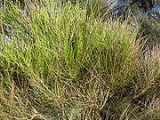
Casuarina glauca
Encyclopedia
Casuarina glauca, commonly known as the swamp she-oak, is a species of Casuarina
native to the east coast of Australia. It is found from central Queensland south to southern New South Wales. It has become naturalised in the Everglades
in Florida where it is considered a weed.
The larvae of the she-oak moth, Pernattia pusilla
, feed on C. glauca.
C. glauca is an actinorhizal plant
producing root nitrogen-fixing nodules infested by Frankia
. There is a regular pattern of cell layers containing flavan
s. Although not a legume, C. glauca, produces a hemoglobin
(not a leghemoglobin
) in its symbiotic root nodules.
Casuarina
Casuarina is a genus of 17 species in the family Casuarinaceae, native to Australasia, southeast Asia, and islands of the western Pacific Ocean. It was once treated as the sole genus in the family, but has been split into three genera .They are evergreen shrubs and trees growing to 35 m tall...
native to the east coast of Australia. It is found from central Queensland south to southern New South Wales. It has become naturalised in the Everglades
Everglades
The Everglades are subtropical wetlands in the southern portion of the U.S. state of Florida, comprising the southern half of a large watershed. The system begins near Orlando with the Kissimmee River, which discharges into the vast but shallow Lake Okeechobee...
in Florida where it is considered a weed.
The larvae of the she-oak moth, Pernattia pusilla
Pernattia pusilla
The She-Oak Moth, Pernattia pusilla, is a species of moth of the Lasiocampidae family. It is found along the coast of eastern Australia.The wingspan is about 30 mm....
, feed on C. glauca.
C. glauca is an actinorhizal plant
Actinorhizal plant
Actinorhizal plants are a group of angiosperms characterized by their ability to form a symbiosis with the nitrogen fixing actinobacteria Frankia...
producing root nitrogen-fixing nodules infested by Frankia
Frankia
Frankia is a genus of nitrogen fixing, filamentous bacteria that live in symbiosis with actinorhizal plants, similar to the Rhizobia bacteria that are found in the root nodules of legumes in the Fabaceae family. Bacteria of this genus also form root nodules.The genus Frankia was originally named by...
. There is a regular pattern of cell layers containing flavan
Flavan
The flavans are a type of flavonoid....
s. Although not a legume, C. glauca, produces a hemoglobin
Hemoglobin
Hemoglobin is the iron-containing oxygen-transport metalloprotein in the red blood cells of all vertebrates, with the exception of the fish family Channichthyidae, as well as the tissues of some invertebrates...
(not a leghemoglobin
Leghemoglobin
Leghemoglobin is a nitrogen or oxygen carrier, because naturally occurring oxygen and nitrogen interact similarly with this protein; and a hemoprotein found in the nitrogen-fixing root nodules of leguminous plants. But nitrogen is necessary for the cycle to occur...
) in its symbiotic root nodules.

